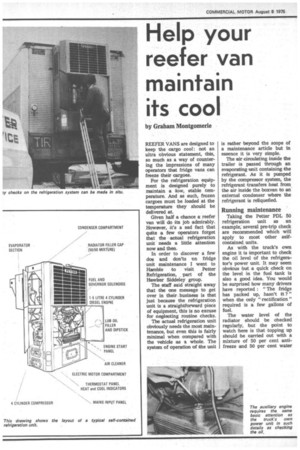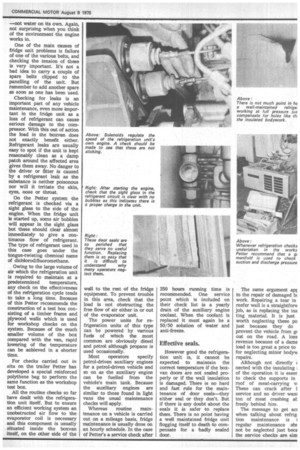Help your reefer van maintain its cool
Page 40

Page 41

If you've noticed an error in this article please click here to report it so we can fix it.
by Graham Montgomerie
REEFER VANS are designed to keep the cargo cool: not an ultra obvious statement, this, so much as a way of countering the impressions of many operators that fridge vans can freeze their cargoes.
For the refrigeration equipment is designed purely to maintain a low, stable temperature. And as such, frozen cargoes must be loaded at the temperature they should be delivered at.
Given half a chance a reefer van will do its job admirably. However, it's a sad fact that quite a few operators forget that the actual refrigeration unit needs a little attention now and then.
In order to discover a few dos and don'ts on fridge unit maintenance I went to Hamble to visit Petter Refrigeration, part of the Hawker Siddeley group.
The staff said straight away that the one message to get over in their business is that just because the refrigeration unit is a straightforward piece of equipment, this is no excuse for neglecting routine checks.
The actual refrigeration unit obviously needs the most maintenance, but even this is fairly minimal when compared with the vehicle as a whole. The system of operation of the unit is rather beyond the scope of a maintenance article but in essence it is very simple.
The air circulating inside the trailer is passed through an evaporating unit containing the refrigerant. As it is pumped by the compressor system, the refrigerant transfers heat from the air inside the boxvan to an external condenser where the refrigerant is reliquefied.
Running maintenance
Taking the Patter PDL 50 refrigeration unit as an example, several pre-trip check are recommended which will apply to most other selfcontained units.
As with the truck's own engine it is important to check the oil level of the refrigerator's power unit. It may seem obvious but a quick check on the level in the fuel tank is also a good idea. You would be surprised how many drivers have reported : " The fridge has packed up, hasn't it ? " when the only " rectification" required is a few gallons of fuel.
The water level of the radiator should be checked regularly, but the point to watch here is that topping up should be Icarried out with a mixture of 50 per cent antifreeze and 50 per cent water —not water on its own. Again, not surprising when you think of the environment the engine works in.
One of the main causes of fridge unit problems is failure of one of the various belts, and checking the tension of these is very important. It's not a bad idea to carry a couple of spare belts clipped to the panelling of the unit. But remember to add another spare as soon as one has been used.
Checking for leaks is an important part of any vehicle maintenance, even more important in the fridge unit as a loss of refrigerant can cause serious damage to the compressor. With this out of action the load in the boxvan does not exactly benefit either. Refrigerant leaks are usually easy to spot if the unit is kept reasonably clean as a damp patch around the affected area gives them away. No danger to the driver or fitter is caused by a refrigerant leak as the substance is neither poisonous nor will it irritate the skin, eyes, nose or throat.
On the Petter system the refrigerant is checked via a sight glass to the side of the engine. When the fridge unit is started up, some air bubbles will appear in the sight glass but these should clear almost immediately to give a continuous flow of refrigerant. The type of refrigerant used in this case goes under the tongue-twisting chemical name of dichlorodifluorornethane.
Owing to the large volume of air which the refrigeration unit is required to maintain at a predetermined temperature, any check on the effectiveness of the refrigeration cycle tends to take a long time. Because of this Potter recommends the construction of a test box consisting of a timber frame and plywood walls which is used for workshop checks on the system. Because of the much smaller volume of the box compared with the van, rapid lowering of the temperature can be achieved in a shorter time.
For checks carried out in situ on the trailer Petter has developed a special reinforced polythene bag to perform the same function as the workshop test box.
All the routine checks so far have dealt with the refrigeration unit itself. But to ensure an efficient working system an unobstructed air flow to the evaporator coil is necessary and this component is usually situated inside the boxvan itself, on the other side of the wall to the rest of the fridge equipment. To prevent trouble in this area, check that the load is not obstructing the free flow of air either in or out of the evaporator unit.
The power units for refrigeration units of this type can be powered by various fuels of which the most common are obviously diesel and petrol although propane is used occasionally.
Most operators specify petrol-driven auxiliary engines for a petrol-driven vehicle and so on as the auxiliary engine can be fuelled from the vehicle's main tank. Because the 'auxiliary engines are similar to those found in light vans the usual maintenance checks will apply.
Whereas routine maintenance on a vehicle is carried out on a mileage basis, fridge maintenance is usually done on an hourly schedule. In the case of Petter's a service check after 250 hours running time is recommended. One service point which is included on their check list is a yearly drain of the auxiliary engine coolant. When the coolant is replaced it must again be a 50/50 solution of water and anti-freeze.
Effective seals.
However good the refrigeration unit is, it cannot be expected to maintain the correct temperature if the boxvan doors are not sealed properly or if the wall insulation is damaged. There is no hard and fast rule for the maintenance of door seals—they either seal or they don't. But if there is any doubt about the seals it is safer to replace them. There is no point having a well maintained fridge unit flogging itself to death to compensate for a 'badly sealed door. The same argument apt to the repair of damaged JD( work. Repairing a tear in reefer wall is a straightform job, as is replacing the ins ting material. It is just worth neglecting these pa Just because they do prevent the vehicle from gi out on the road. A loss revenue because of a darns load is too great a price to for neglecting minor hodyv, repairs.
Although not directly nected with the insulating of the operation it is esser to check the supports in roof of meat-carrying v These can crack after 1 service and no driver wand ton of meat crashing at freely behind him.
The message to get aci when talking about refrig don maintenance is regular .maintenance sh not be neglected just beca the service checks are sim




































































































